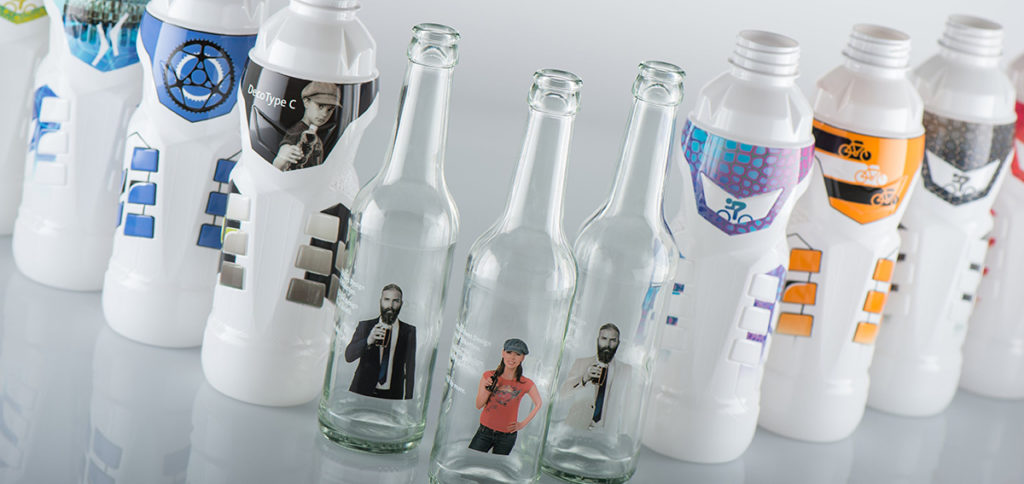Modern labeling technology offers flexibility

The increasing assortment of beverage and packaging varieties in the non-alcoholic beverage industry, as well as, rapidly changing design features represent a challenge to the labeling technology sector. Flexible solutions are needed that deliver perfect labeling results. Furthermore, the focus is on rapid product and format changes as well as on simple operation.
Labeling technology serves as the link between engineering and marketing.
Because it must fulfill all requirements, labeling technology serves as the link on the beverage production chain from engineering to marketing. After all, it is the label that communicates with consumers at the point of sale. If the label is of poor quality, then it is the label that can cause the consumer to select another producer’s beverage. Consequently, precision is a basic requirement when investing in labeling technology.
Another aspect that is increasingly factored in labeling technology investment decisions is flexibility. Different beverage packaging versions and sizes frequently need to be handled on a single labeling machine. Furthermore, the need of a single labeling machine to be capable of handling multiple labeling processes is of major importance to many beverage producers. What is also increasingly important is the ability to produce very small batch sizes at minimal – or even better – zero changeover times. Manufacturers of labeling machines are satisfying the requirements of the non-alcoholic beverage industry by providing a range of different solutions.
Multi-technology machine vs. specific machine
For example, Sidel focuses on modular technology with its new range of “Evodeco” labelers. It enables beverage producers to either produce several labeling applications for PET, HDPE or glass on a multi-technology machine, or to opt for a single labeling application on a specific machine. According to Sidel, this platform configuration always allows beverage producers to select the solution that meets their own particular labeling requirements and specified output. In other words, the multi-labeler, featuring up to four different labeling technologies (roll-fed, PSL, cold glue or hot glue), is just as much of an option as purely PSL, cold glue or roll-fed labelers. Just recently, for example, the company delivered a roll-fed-only labeler to water producer Levissima, which is part of the Sanpellegrino group. Its two labeling stations enable it to handle 1.5l rectangular plastic bottles. In this instance, the focus was not on labeling different bottles using a wide range of labeling methods, but on handling, with extreme precision, both very light rectangular packaging and very thin labels.
Focus on can labeling
In line with a “flexible, resource-saving and compact” motto, KHS is also showcasing its latest labeling machine product – the “Innoket Neo” range of models for cans. According to the manufacturer, the goal of this new product is to provide more design options and faster design application at lower storage capacities. The labeling machine mentioned above enables self-adhesive film or paper labels to be applied to cans. Here, partial or full wraparound of the packaging is feasible. This machine is particularly aimed at small-batch manufacturers, as well as producers with a high degree of brand diversity.
Digital printing is defined as a printing method which involves a printed image being transferred directly from a computer to a printer or plotter. Static types of printing like film or plate exposure are not required in digital printing. That simplifies the specific design of individual print sheets. The label can also be printed immediately after it has been designed. Digital print is one of the fastest printing methods.
Another “tender shoot”: digital print
Still in its early stages within the beverage industry, “tender shoot” could grow faster than anticipated. We’re talking about digital print for beverage packaging. Krones is a pioneer in this field. Its subsidiary Dekron is a provider of not only the machine technology but also of the entire process. Its comprehensive package includes both press and printing inks, as well as defining and implementing process characteristics and configuring the workflow. According to the manufacturer, this means that bottling companies can utilize the benefits of direct-to-substrate printing immediately after commissioning. Dekron now has four different direct-to-substrate presses in its portfolio for glass, PET and HDPE that differ in terms of performance and types of packaging that can be printed. The system prints up to eight colors and achieves a resolution of 360 dpi. Print height of up to 190 mm provides plenty of design space.
A key benefit of direct-to-substrate printing is that innovative packaging design is feasible. Grooves and elevations can be printed and packaging featuring embossing or debossing can be specifically decorated. At the same time, 3D effects can be created and the look and surface feel can be blended into a multisensory experience. Even customized artwork is feasible.

Another benefit of digital packaging design is that it does not involve the procurement and storage of labels, small batches can be produced cost-effectively and market changes can be reacted to immediately. Special editions are easy to create. Take the FIFA World Cup for example: digital printing enables the World Cup winner logo to be printed on bottles immediately after the winning team has been crowned world champions. Bottles are even handed out to fans as they exit the stadium. Digital print even makes batch sizes of one an option – a key aspect of beverage customization.
Is it set to make its labeling technology breakthrough?
Although it is still in its infancy in the beverage industry, there are plenty of indications, in an increasingly digital world, that digital printing is set to make a breakthrough here, too. Although traditional labeling methods will continue to have their raisons d’être, it will continue to make sense in the future to apply them to products where consumers expect uniform labeling. Rapid changeovers to different types of packaging and labeling technologies, simple operation and maintenance, compact design, high efficiency, low TCO, and above all labeling quality will, in the future, be the factors by which they will be rated, and on which buying decisions will be based.
